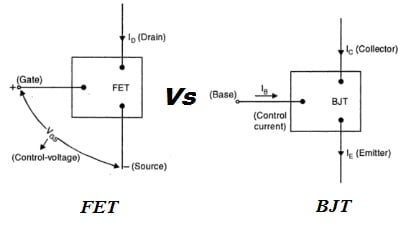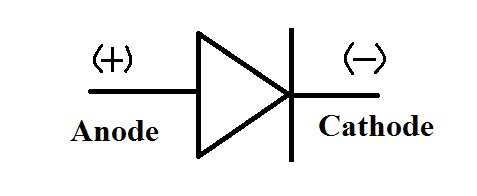Table of Contents
Bipolar Junction Transistor
A bipolar junction transistor (BJT) has emitter (E), base (B), and collector (C) regions made of either P-type or N-type semiconductor materials with a provision for three connecting terminals to the three semiconductor material regions. The three terminals of the device are the emitter, base, and collector. There are two types of transistors, one of them N-P-N type and the other P-N-P type, based on the semiconductor materials used in the device.
Bipolar Junction Transistor is a device that transfers a weak signal from a low-resistance circuit to high resistance circuit and is named a transistor. “Trans” means transfer property and “istor” means resistance property offered by the junctions.
In the figure shown below, the transistor consists of three layers, the emitter layer, the base layer, and the collector layer. Between the base and emitter regions, one P-N junction J1 exists, which is known as the input junction or the emitter junction. A second P-N junction J2 exists between the base and collector regions, which is known as the output junction or the collector junction.
Short History of Transistor
The invention of the transistor by American physicists Jone Bardeen, Walter H. Brattain and William Shockley, later jointly awarded a Nobel Prize, was announced by the Bell Telephone Laboratories in 1948. It was also independently developed nearly simultaneously by Herbert Matare and Heinrich Welker, Germam physicists working at Westinghouse Laboratory in Paris.
Types of Bipolar Junction Transistor
There are two types of transistors:
- NPN Transistor
- PNP Transistor
NPN
A transistor in which two blocks of n-type semiconductors are separated by a thin layer of p-type semiconductor is known as an NPN transistor.
PNP
A transistor in which two blocks of p-type semiconductors are separated by a thin layer of n-type semiconductor is known as a PNP transistor.
In both types of transistors, the following points are worth noting:
- There are two pn junctions connected back to back. In other words, a transistor may be regarded as two crystal diodes connected back to back. The diode on the left is called the emitter-base diode or simply the emitter diode. Whereas, the diode on the right is called the collector base diode or the collector diode. These names are given as per the names of the terminals of the transistors.
- Transistor has three terminals taken from each type of semiconductor.
- The middle section is made of a thin layer which is a very valuable point for the functioning of a transistor.
- The terminals of transistor can easily find via digital multimeter.
Transistor Terminals
Every transistor has three terminals called emitter, collector and base.
Emitter :
- A portion which is situated at outer side of the transistor that injects a large number of majority carriers is called emitter.
- It is always placed in forward biased as compared to base so that it can produce a large number of majority charge carriers (electrons in case of NPN transistor and holes in case of PNP transistors) into the base.
- The emitter is heavily doped but moderate in size because it supply or inject a large number of majority carriers into the base region.
Collector :
- It is the other outer region situated in the other side of transistor which collects the maximum amount of majority charge carriers those are supplied by emitter.
- The collector is always placed at negative voltage as compared to base (i.e, collector-base junction is reverse biased) because to remove majority charge carriers from its junction.
- The doping of collector is between the heavy doping of emitter and light doping of base, but larger in size because it collect maximum amount of majority charge carriers.
Base :
- The middle section which forms two P-N junctions between emitter and collector is called base.
- The base forms two circuits, one input circuit with emitter and the other output circuit with collector.
- The base-emitter junction is forward biased, providing low resistance for the emitter circuit.
- The base-collector junction is reverse biased, offering high resistance path to the collector circuit.
- The base is lightly doped and very thin so that it can pass on most of the majority carriers supplied by the emitter to the collector.
Unbiased Transistor:
- When a transistor is unbiased, two P-N junctions are formed. The free electrons diffuse across the junctions forming two depletion layers.
- For each of these depletion layers, the barrier potential is nearly 0.7 V at 250 C for a silicon transistor (0.3 V for a germanium transistor).
- The width of the two depletion layers will be different as the three regions are doped at different levels.
- The more heavily doped region is the greater is the concentration of ions near the junction.
- This means that the depletion layer penetrates slightly into the emitter region (heavily doped) but deeply into the base (lightly doped). Therefore, the depletion layer formed at the emitter junction is small.
Symbols
For the sake of convenience the transistors are generally represented by schematic diagrams (i.e., symbols). The symbols for NPN and PNP transistors are shown below.

Some important facts about transistor
- A transistor has three regions, namely emitter, base and collector.
- The emitter is heavily doped so that is can inject a large number of charge carriers (majority carriers electrons or holes) in to base. It is moderate in size. The base is lightly doped and very thin so that it can allow most of the charge carriers to diffuse across this region and reach the collector space charge layer. The collector is intermediately doped and large in size so that it can dissipate the heat produced at the collector junction.
- There are two junctions one is between emitter and base and is called emitter junction, whereas the other one is between the collector and base and is called collector junction.
- The depletion layer at the emitter junction is quite small as compared to the depletion layer at the collector junction.
- For perfect operation of a transistor (an amplifier) the emitter junction is forward biased, whereas the collector junction is reverse biased.
- The forward biased voltage VEB is very small, whereas the reverse biased voltage VCB is very large.
- The resistance of emitter junction is very small, whereas the resistance of collector junction is very large.




